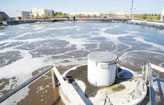Treasures that lie beneath
Updated: 2011-05-13 10:51
By Zhang Zixuan (China Daily European Weekly)
 |
|
Salvage work on the Nanhai No 1 wreck is under way in the specially built Crystal Palace in Yangjiang, Guangdong province. Photos by Zhang Zixuan / China Daily |
Underwater delight
On Dec 22, 2007, what is thought to be the oldest and largest shipwreck ever found in China was hauled - with its surrounding silt and water - from the South China Sea bed where it had rested for more than 800 years. The 5,000-ton Nanhai No 1, dating to the Song Dynasty (960-1279), is believed to have within its holds over 60,000 to 80,000 relics.
Six days later, it was moved to the specially built Crystal Palace at Guangdong Marine Silk Road Museum in Yangjiang, Guangdong province. Salvage operation on the wreck can be watched through a glass pool, replete with temperature and pressure controls, that replicates the exact sea environment. The salvage project is expected to run for some 10 years, say officials.
"Shifting the entire wreck from the sea to a new on-site location is a momentous feat, as it has not been done by any other nation till date. It will be of immense value to future underwater archeology developments across the world," Shan says.
Unlike land, underwater cultural heritage protection is more challenging, demanding and riddled with difficulties, says Liu Shuguang, dean of the Chinese Academy of Cultural Heritage and director of the National Conservation Center for Underwater Cultural Heritage.
"Two scoops will be sufficient for land archeology sometimes. But underwater archeology requires huge amount of money and the most advanced technology," he says.
According to Liu an underwater archeology project can cost several millions of yuan. He says that the rental charges of the workboat used for the excavation of Nan'ao No 1, alone run into 80,000 yuan every day. Other factors like water temperature and visibility apart from the fact that it is dangerous makes the operation more difficult, Liu says.
The third national cultural heritage census, in 2009, determined there are about 70 ancient shipwrecks in China's ocean territory, but the National Conservation Center for Underwater Cultural Heritage estimates there are 2,000 or more in just the South China Sea. But it is very difficult to confirm their locations.
Liu also said the law on underwater cultural heritage protection is less comprehensive than the one on land cultural heritage protection. For example, many large-scale underwater constructions are launched without prior underwater archeology prospecting.
 |
|
From left: An archeologist works on items discovered in the Nanhai No 1 wreck; a technician from Fujian Museum cleans pottery; two pieces of relics discovered from the fourth round of salvage operations on the Nan'ao No 1 wreck. |
Preservation mode
The 2001 UNESCO Convention on the Protection of the Underwater Cultural Heritage recommends that in-situ preservation, which means to preserve the cultural heritage where it was underwater, is "considered as the first and preferred option before allowing or engaging in any activities directed at this heritage".
The reason for that is that "under normal circumstances, heritage is well preserved underwater owing to the low deterioration rate and lack of oxygen, and that it is therefore not per se in danger", says the UNESCO guideline.
"Once out of the water, the heritage will significantly lose its cultural and historical context and value," Liu says.
Another critical defect of departing from water is the damage that it may do to underwater relics. "The most common varieties of underwater cultural relics are porcelain, wood-and-lacquer, and metal wares, with porcelain artifacts being the predominant," says Zhang Huanxin, director of the Preservation Department at the Fujian Museum.
"They also have to withstand the severe sea salt effects. Hundreds of years' immersion in seawater has made sea salt seep into the porcelain structure. After being exposed to air the sea salt will dry and crystallize within the porcelain. This will expand the artifact and subsequently it will crack up," Zhang says.
"All the excavated underwater porcelain needs to be immersed again in water to remove the sea salt. The complicated procedure may last for many years," he says.
China, however, does have successful examples of in-situ preservation. In 2009 China constructed its first underwater museum - the Baiheliang Underwater Museum, which is an arch-shaped pressure-free water container, covering a 1,600-meter-long and 25-meter-wide stone ridge engraved with inscriptions that record 1,200 years of water-level changes.
However, more underwater cultural heritage sites such as Nanhai No 1 and Nan'ao No 1 had no choice but to be rescue-excavated to avoid being destroyed by relic thieves'.
E-paper

Tapping into the future
Foreign companies are investing in China's water industry as many predict a growing profit margin.
Headhunters ride on growth
Commercial property rides wave
Learning from the past
Specials

Cuisine central
London's Chinatown is helping diners appreciate full palate of Chinese food

Tying the knot
Danish couple's high-end macrame export business takes off in the mountains of Yunnan.

Truly a super woman
Li Yuchun first came to prominence in 2005 as the Super Girl winner, and since then has become an international star.
